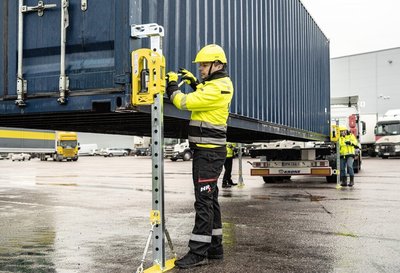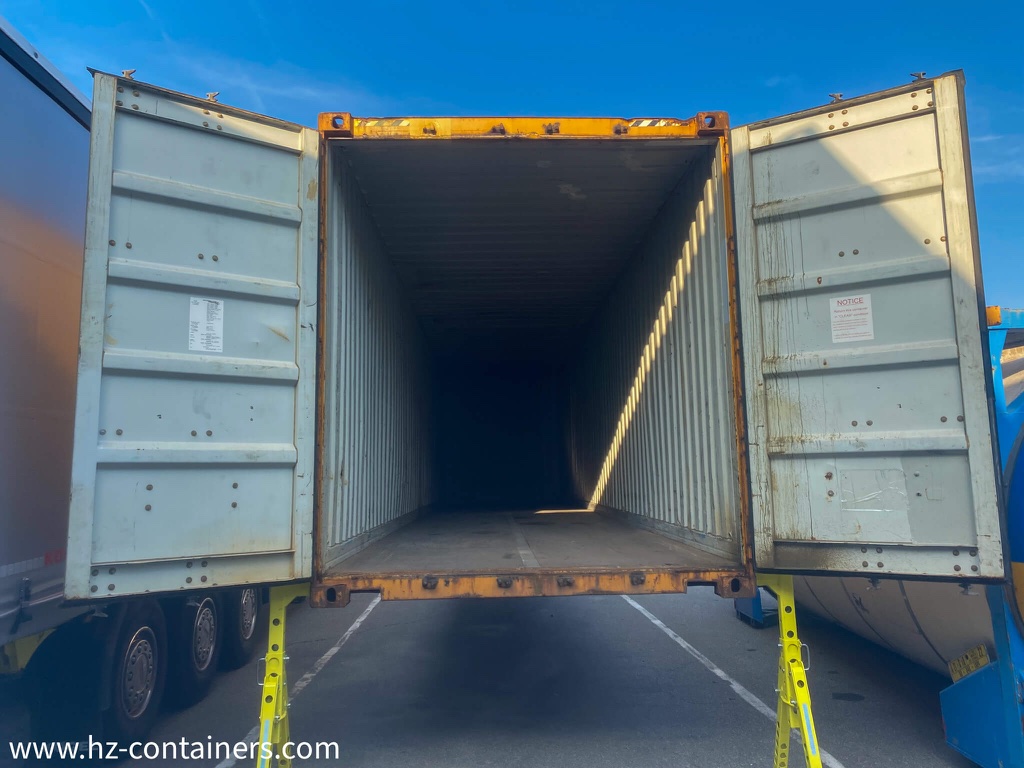Definition and Functionality
ISO container leveling legs are adjustable supports designed to stabilize shipping containers on uneven or sloped surfaces. These legs attach firmly to the container’s corner castings, the reinforced points located at each corner. This setup ensures that the container is raised and leveled properly. With precise height adjustments, the legs create a flat and stable base for the container. This is essential for maintaining the container’s structural strength and ensuring smooth operation. These legs are especially useful on uneven ground, where they prevent tilting and help align doors and other components correctly.
Importance and Use Cases
Leveling legs help maintain the stability and usability of shipping containers. When a container isn’t leveled, problems like doors not closing properly, structural strain, and uneven weight distribution can occur. These issues can damage the container and its contents. Leveling legs solve these problems by providing strong support and even weight distribution.
You’ll often see ISO container leveling legs used in storage setups, modified container housing, and construction site offices. In these cases, the legs provide a steady base, keeping the container secure during its use. They also lift the container off the ground, preventing water from pooling underneath. This reduces the risk of corrosion and long-term damage.
By using leveling legs, you can enhance the safety, durability, and efficiency of shipping containers in a variety of applications.
Benefits of Using ISO Container Leveling Legs
Enhanced Stability and Safety
ISO container leveling legs improve stability, especially on surfaces that are uneven or sloped. These legs support the container at its corner castings, preventing structural distortions that might occur if the container is positioned incorrectly. A properly leveled container reduces the risk of tipping or shifting, which is particularly important when dealing with heavy loads or challenging weather. This stability also helps protect anyone working in or around the container, reducing the chance of accidents caused by sudden movements.
Ease of Use and Precision
The adjustable design of ISO container leveling legs lets you make precise height adjustments, making it easier to create a level surface. This feature is especially helpful during the setup or relocation of containers. Unlike makeshift solutions like wooden blocks or gravel, leveling legs are designed for efficiency and convenience. They are simple to use, require little effort, and deliver reliable results.
Prolonged Container Lifespan
Proper leveling helps reduce stress on the container’s structure. This lowers the chances of warping, cracking, or issues like doors becoming misaligned. By preventing water from pooling and ensuring the weight is evenly distributed, leveling legs help protect the container from rust, corrosion, and foundational damage. This extends the container’s lifespan and lowers maintenance and repair expenses, making it a practical choice for long-term use.
Using ISO container leveling legs keeps containers stable, functional, and durable across various situations, ensuring safety and longevity.
Tools and Materials Needed
To properly install and use ISO container leveling legs, you need the right tools and materials to ensure stability and accuracy. Below is a clear breakdown of what you’ll need:
Essential Tools
Wrench or Socket Set
You will need a wrench or socket set to securely fasten bolts when attaching the leveling legs to the container. These tools help create a firm and stable connection to the corner castings.Spirit Level
A spirit level is important for making sure the container is perfectly horizontal. This tool prevents misalignment, which could cause structural issues or problems like uneven door alignment.Protective Gear
Use safety gloves and protective eyewear to protect yourself from injuries during installation. These items help reduce risks from sharp edges or falling tools.Hydraulic Jack (Optional for Heavy Lifting)
A hydraulic jack can lift the container slightly off the ground, making it easier to position and attach the leveling legs. Choose a jack with a lifting capacity of at least 12 tons for the best results.
Optional Accessories
Leveling Pads
Leveling pads increase stability, especially on soft or uneven surfaces. These pads help distribute the container’s weight evenly and stop the legs from sinking into the ground.Wooden Planks or Boards
Wooden boards, such as 2”x6”x2’ planks, can be placed under the leveling legs for better weight distribution and added stability on challenging terrain.
Preparation Tips
Check that all tools are in proper working condition before you begin. Organize the tools and materials within easy reach to make the process smoother and save time. Using the right equipment will make the installation safer, quicker, and more effective.
This list ensures that setting up ISO container leveling legs is accurate and secure, helping to maintain the container’s stability and functionality over time.
Step-By-Step Guide to Using ISO Container Leveling Legs
Step 1: Prepare the Site
Clear the area where the container will sit by removing any debris, vegetation, or obstacles. Make sure the ground is as level as possible and compacted to create a stable base. Mark the exact spots where the leveling legs will go, primarily at the container’s corners. If needed, prepare a strong foundation, such as concrete pads, to improve stability.
Step 2: Attach the Leveling Legs
Fasten the leveling legs to the container’s corner castings. These legs are typically designed to fit standard ISO corner castings. Align them properly, and use the bolts or clamps included in the leveling leg set to secure them tightly. Make sure the bolts are firm but avoid over-tightening, which could damage the materials.
Step 3: Adjust the Height
Use the adjustable mechanism on each leveling leg to raise or lower the container until it is evenly leveled. Place a precise spirit level on the container’s floor to check alignment across its width and length. Adjust one leg at a time and check the level frequently to prevent putting unnecessary strain on the container’s frame.
Step 4: Secure and Test Stability
After leveling the container, recheck all bolts and fastenings to ensure they are secure. Test the container’s stability by gently applying pressure to confirm it doesn’t wobble. Use the spirit level again to verify the alignment. If the leveling legs include anchoring options, fasten them to the ground to prevent any movement or shifting.
By following these steps, you can keep your ISO container stable and level, reducing the risk of structural issues or environmental impacts. Inspect the installation regularly to ensure it stays reliable over time.
Common Mistakes to Avoid
Neglecting Ground Preparation
Skipping proper ground preparation is a common mistake when setting up ISO container leveling legs. If the ground is uneven, soft, or covered with debris, it can make the container unstable, leading to tilting or shifting over time. Seasonal changes, like freezing and thawing, can worsen this instability and cause further misalignment. To avoid these issues, always ensure the ground is even, firm, and free of debris before you start the installation.
Improper Installation of Leveling Legs
Attaching or tightening leveling legs incorrectly can create serious problems. If you tighten the bolts too much, you might damage the container’s corner castings or the leveling legs themselves. On the other hand, if the bolts are too loose, the legs can detach, making the container unstable. Always follow the manufacturer’s instructions carefully. Use the correct tools and double-check that the legs are securely fastened.
Ignoring Regular Maintenance
Failing to inspect and maintain leveling legs regularly can lead to problems like rust, wear, or mechanical failure over time. Small issues, such as loose bolts or minor corrosion, can grow into bigger problems that compromise the container’s stability. Make it a habit to check the leveling legs for damage, clean off dirt and debris, and lubricate moving parts. This ensures they function smoothly and last longer.
Overlooking Adequate Drainage
Not planning for proper drainage around the container can result in water collecting near the base. This pooling can erode the ground, causing the container and its leveling legs to sink or shift. Poor drainage also increases the risk of structural problems, like rust and corrosion. To prevent these issues, create a drainage solution, such as adding a slight slope or installing a French drain system, to redirect water effectively.
Using Inadequate Support Materials
Using weak or unstable materials to support the container can lead to sagging or uneven placement. For example, untreated wood or poorly chosen support points may not handle the weight of the container or withstand environmental conditions. Instead, use strong materials like concrete or steel blocks. Place them strategically to distribute the container’s weight evenly and ensure reliable support.
By addressing these common mistakes, you can ensure that ISO container leveling legs work as intended, providing a solid and secure foundation for your container.
Maintenance Tips for ISO Container Leveling Legs
Taking care of ISO container leveling legs helps keep them working safely and effectively for a long time. Follow these steps to maintain them properly:
Cleaning and Lubrication
Dirt, debris, and moisture can cause rust and stop the leveling legs from working correctly. Clean the legs regularly using a damp cloth or mild detergent to remove dirt and prevent rusting. Focus on the joints and moving parts where dirt often collects. After cleaning, make sure to dry all the parts thoroughly. Apply a high-quality, weather-resistant lubricant to the adjustable mechanisms and hinges. This keeps the parts moving smoothly and reduces wear caused by friction.
Damage Inspection
Check the leveling legs regularly for any signs of damage or wear. Look closely for cracks, bending, or rust on the legs and their attachments. Also, inspect the bolts and fasteners to ensure they are tightly secured and free from corrosion. If you find any parts that are heavily damaged or structurally weakened, replace them immediately to prevent accidents or malfunctions.
Proper Storage
When you are not using the leveling legs, store them in a dry and covered location. Avoid leaving them exposed to harsh weather conditions like rain or extreme temperatures, which can cause rust and weaken the materials. If you cannot store them in a controlled space, use protective covers to shield them from the elements. Proper storage helps maintain the legs’ condition and prevents early damage.
By following these cleaning, inspection, and storage steps, you can keep your ISO container leveling legs reliable and extend their lifespan.
Alternatives to ISO Container Leveling Legs
When ISO container leveling legs are not an option, you can use other methods to stabilize containers on uneven ground. These alternatives differ in how effective, durable, and practical they are, depending on the situation.
Temporary Solutions
Wooden Blocks: Wooden blocks are a simple and affordable way to level containers. You can stack them to adjust the height and balance. However, they are not very precise and may not last long, especially under heavy loads or in wet conditions where the wood can warp or deteriorate.
Concrete Slabs: Concrete slabs, whether pre-cast or poured on-site, provide a solid and long-lasting foundation for containers. They work well for semi-permanent setups but need extra preparation, such as leveling the ground and waiting for the concrete to set. This process may not be suitable if you need a quick solution.
Adjustable Metal Supports: Metal jacks or stands with adjustable heights can function similarly to leveling legs. They are strong and reusable, but you will need to spend time positioning and securing them correctly to keep the container stable.
Comparing Effectiveness
Temporary options like wooden blocks and concrete slabs can provide basic stabilization, but they are less effective than ISO container leveling legs. Wooden blocks might shift over time, and concrete slabs require extensive groundwork to install. Adjustable metal supports are more functional and closer in performance to leveling legs, but they are not as convenient because they do not integrate directly with container corner castings.
For long-term use, ISO container leveling legs remain the best option because they are specifically designed to be durable, easy to use, and efficient. If leveling legs are unavailable, temporary alternatives like wooden blocks or metal supports can work as short-term solutions.




